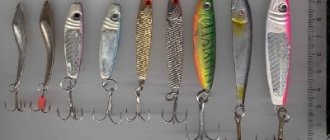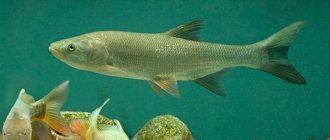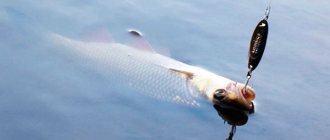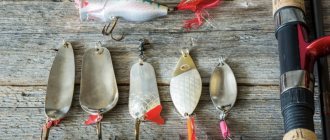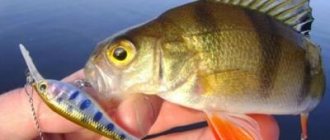Yuri 06.11.2020 643
Astrakhan fishermen often use spinning rods and artificial baits to fish for asp. But few people cover the topic of catching asp with live bait. Therefore, we decided to analyze in detail the tactics and features of catching asp with live fish from the shore. Regardless of the type of reservoir and time of year, such fishing does not allow you to remain without a catch.
When is the best time to catch asp with live bait?
The tackle is used at any time of the year. Sheresper, as our predator is also called, is actively caught with live bait until the freeze-up. In winter, its activity weakens significantly - it is very rare to see a predator on a hook. The individual is diurnal, and maximum activity occurs in the early morning and twilight. Low lighting forces the asp to retire - its bites practically disappear. In autumn, in search of food, it sticks to sandbanks and spits.
- Advice! To detect prey, we pay attention to the characteristic whipping splashes - the asp jumps out of the water and beats with its tail. Activity can be observed from a distance.
To fish with live bait from the shore, we go fishing in stable weather with long-standing pressure. We give preference to the place where flocks of fry are concentrated. If a storm or heavy rain is approaching, the Sheresper hides and leads a passive lifestyle until normal weather conditions are restored. There is practically no reaction to live bait.
A float rod is the main gear for catching asp with live bait.
Asp, or as it is also called, sheresper, is a very cautious fish, and spinning anglers, when going fishing, have to carefully select artificial bait that can convince this predator of its naturalness. When fishing with live fish, this problem disappears, since the asp sees the prey in its natural form in front of him. One difficulty remains - to camouflage as much as possible the equipment that supports the fish in the water column.
This purpose is best served by float tackle. Its components are as follows: Rod. Asp most often live on rivers, so you should use a match or spinning blank. It would be more logical to use a Bolognese fishing rod, which is more suitable for wire fishing, but in the process of catching sheresper you can come across very impressive specimens, and a rod of this kind may not withstand the impressive load.
Coil. The choice of this element of gear depends on the nature of the fishing. If you plan to fish from the shore and at a decent distance, then you should choose an inertia-free reel that allows you to cast to the selected point. An inertial reel is a good choice for live fishing from a boat or at a short distance from the shore. In both cases, the reels must be well suited to hold back the jerks of strong fish.
Fishing line. Braid is highly visible in the water and is rarely used for this fishing method. Therefore, as the main line, fishermen use a fishing line made of transparent materials with a diameter of up to 0.4 mm. The leash is most often knitted from fluorocarbon fishing line, which is hardly noticeable in the water, quite strong and rigid.
Float. To catch such cautious fish, the float should be inconspicuous. Therefore, in this capacity they use either a plastic ball filled with water for loading, or transparent special floats with a large carrying capacity. The second option is convenient because such floats have a colored antenna or a rounded top, which is noticeable from afar and clearly registers a bite.
Hook. This element of equipment for asp fishing is selected depending on the method of attaching live bait. There can be either a single hook that clings to the lip of the fish, or a tee threaded under the upper fin. Combinations of different methods are also possible.
Sinker. This element is used depending on the fishing horizon. When using a water balloon, there is no need for it, since the bait must be in the upper horizons; if a light float is used, then a load will be required.
Tactics for catching asp from the shore
Catching asp with live bait from the shore is similar to perch fishing. The running donka is also used for fishing for small grass pike. The principle of fishing is that the fisherman needs to cast a tackle and float along the shore with the current. The rod and the degree of tension of the fishing line allows you to control the trajectory and movement of the equipment. As soon as we have passed the promising fishing zone, we reel it out and re-throw the gear. If fishing conditions do not allow long walking, the fisherman can use a short retrieve while standing still.
- Attention! We make sure to disguise ourselves as the conditions of the reservoir, since the asp has excellent eyesight and hearing. He gets scared of any suspicious object and refuses to throw. We don’t dress brightly, we hide in the coastal bushes, like a real hunter.
If we fish the shore with a bottom, we do not move along the shore, but install gear and secure it along the shore. It is important to remember that calmness, the absence of loud stomping and camouflage in a pond are the key to successful asp fishing from the shore.
Tackle and bait for asp fishing
Kastmaster is one of the best spinners for asp
It is recommended to use a spinning rod from 3 m in length and a cast of 50-70 g. A spinning reel with a large spool from 3000, or a multiplier for long range. Remember to wind the line almost to the edge of the spool so that the bait flies as far as possible.
The asp does not have teeth that are dangerous for biting the fishing line, however, take care of its strength. You can use either regular monofilament line from 0.2-0.25 in diameter or braided line.
Equipment for asp fishing can contain a variety of baits and fishing methods:
The castmaster is the best bait due to its weight and long casting capabilities. When fishing for asp, it is recommended to use a castmaster weighing at least 30 g .
Devonian. This bait is not so popular among fishermen, but it is capable of showing good results when catching this large predator. Be sure to use a swivel in the tackle so that the Devon does not twist the line. This bait is quite weighty, which allows you to cast it over long distances.
Spinner spoons for pike weighing 30-45 g have also proven themselves well when catching sheresper.
Jig baits should also be in the spinner’s arsenal, especially during the period of deep-sea asp fishing in the spring.
Catching asp with a popper and wobbler can also work well. When guiding the wobbler, try to achieve the effect of rarely striking the bait on the bottom. The disadvantage of these baits is the lack of weight for long-distance casting, but you can attach them to jig rigs, for example, to a retractable leash, and the casting range will increase.
Sbirulino. Tackle with bombard and streamer
Bombarda (or sbirulino) is also a very effective tackle, containing a large float that can be easily cast over a long distance, and the tackle moves along the top. Sbirulino is a float with a large carrying capacity.
Boat/sleigh. Another unique tackle that allows you to successfully catch asp and chub.
Front sight/wabby/streamer. The fly often acts as a secondary bait in the tackle and is attached to a leash in front of the main bait, half a meter from it. To prevent the line from twisting, you can use a swivel. Also sometimes they use spinner spoons with feathering like a fly near the hook, this can also give a positive result during fishing. A wabik is a bright fly with a double (hook). The streamer is another type of fly with dense plumage.
3 types of asp flies
Dark streamers
White streamers
5 types of flies for asp
Fishing with live bait . Asp is a predatory fish and its main prey is bleak, topwater and other small fish. There is quite a lot of gear capable of catching fish no more than 5-6 cm long on a hook.
It can be:
- float rod,
- bombard,
- bottom tackle for fishing in shallows,
- bait on one of the spinning baits.
We mount live bait tackle
Experienced fishermen recommend using a fishing rod for long-distance casting. Its purpose is fishing from the shore, even if different horizons of the predator’s parking area are noted. We give preference to a match or spinning rod with a test weight of 15-40 g. Depending on how far the bait will have to be cast, we decide on the action and length of the rod. For coastal fishing for asp, a medium or slow blank of 3-5m is suitable.
As a reel, we give preference to the inertia-free model. It is important to maintain perfect balancing of the rod and reel so that the angler’s hand does not get tired from exhausting casts. The line should be well laid on the reel. A velvety ride and high-quality friction are the key to successful fishing. We wind monofilament with a diameter of 0.28-0.35 mm onto the reel. The breaking load should not be lower than 5 kg. Nylon fishing line is great for long casts; it does not look suspicious in the water and is able to absorb the resistance of a predator.
The float does not signal a bite, but shows where the bait is currently located. Therefore, a float can be a ball filled with water. This makes the tackle heavier and casts more accurately.
- Attention! Since the asp belongs to the group of cautious predators, the tackle should be as inconspicuous as possible.
For the rig, we need a leash, a hook and a lead weight. The leash is made from fluorocarbon or monofilament fishing line with a cross-section smaller than that of the base fishing line. The length of the leash is at least 70 cm, which is determined by the fishing conditions and the horizon of the asp’s location.
Single or double hook. When we assemble the equipment, we make sure that the hook is located at a distance from the float and does not behave suspiciously for a predator. When we fish the upper layers of water, we do not surround the equipment. Otherwise, you cannot do without the use of round lead sinkers if the live bait must be located at a certain depth.
Features of catching asp with a beard (streamer)
Catching asp on a spinning rod using a streamer is distinguished by its catchability, since the nozzle imitates mice, fry and toads well. Artificial materials, feathers and fur are often used to make a beard. The listed components hold well in water and allow high-quality imitation of prey.
Each type has its own characteristics:
- artificial. Particularly effective when hunting perch and pike perch. They keep their shape better than others, dry quickly, but lose their play when fishing in an intense current;
- feather Experienced fishermen always use feather options for asp, as they have an even and smooth game even during fast retrieves or fishing in the current. To improve the equipment, add a head made of deer fur; such equipment holds even better in fast currents;
- fur. They are universal models, suitable for any water surface. They do not lose their play during strong currents and remain attractive in still waters. Most often used for catching pike.
The best bait for fly fishing is an asp beard.
There are other features of the asp beard tackle:
- Asp are caught using a streamer during periods of low activity, especially in the heat. With the correct presentation, the fish’s hunting instincts awaken, then it attacks the bait;
- if you successfully throw the bait directly into a school of sheresper, there is a high probability of catching 2 individuals in one landing;
- the choice of this bait is justified in areas with an abundance of underwater vegetation and snags. When fishing with a spinning rod or fly fishing, the barb has less chance of getting tangled under water due to the compactness of the bait;
- It is good to fish with a streamer at all depths. After an accurate cast, you can catch the asp in deep holes or perform surface retrieves;
- The manufacturing technology uses lightweight materials that do not allow long casts. A sinker is used to deliver bait over long distances;
- the bait is suitable for fishing on any current using different fishing styles, since it does not sail and is resistant to entering a corkscrew;
- The beard rig for asp fishing can be used in all seasons and shows good results all year round;
- It is important to make accurate casts right away; fur models quickly get wet and lose their catchability. Synthetic and feather options are better able to withstand getting wet;
- It is better to attach attractive devices to the tail of the streamer, but not bright ones. Beards that imitate the appearance of the inhabitants of a particular body of water perform better. The colors may be different, but the following products show themselves well on asps: gray, white and black products. Some bright colors help catch asp, but solid varieties are still better;
- The asp attacks prey that is 4-5 times smaller than itself. Taking this feature into account, the nozzle is prepared from 5 to 8 cm in length.
How to properly mount live bait
As live bait we use the fry that the asp feeds on in the pond in question. For this predator, bleak is preferred, which is why we choose bleak, roach, chub or gudgeon that are similar to it. Live bait should not be more than 10 cm in length. Fresh and active fish are the most desirable prey for the sheresper. We create appropriate conditions for storing bait.
Catching asp from the shore with live bait involves 2 options for bait attachment. In the first case, you can hook the hook to the lip, in the second, you can bring the hook through the gills into the mouth. Most Astrakhan fishermen prefer the second method, since this way the hook does not fly off when a predator bites.
What do experts advise?
Based on practical recommendations from advanced fishermen, we note:
- To cast the equipment correctly, it is better to use a float tackle for casting at a distance. The productivity of bombards and donkeys is significantly lower.
- We use bleak as live bait for catching asp.
- Fishing will not be successful without camouflage and caution.
- The predator's maximum activity occurs in the early morning or evening sun, when a slight breeze blows and clouds are visible.
Also, do not forget about the favorable period for catching asp with live bait - in Astrakhan this is October and November. Among the promising places it is worth highlighting bridge areas, rifts or shallows. The predator is also most active on steep banks or areas of flooded trees.
TAGS:
Tags
Carp Buffalo Spring Vobla Asp Winter Crucian Rudd Summer Fishing baits Lower Volga Perch Autumn Fisherman's reminder Lures Bite forecast Fishing in Astrakhan Fishing baits Fishing tackle Fishing secrets Catfish Fishing methods Pike perch Catch Pike




